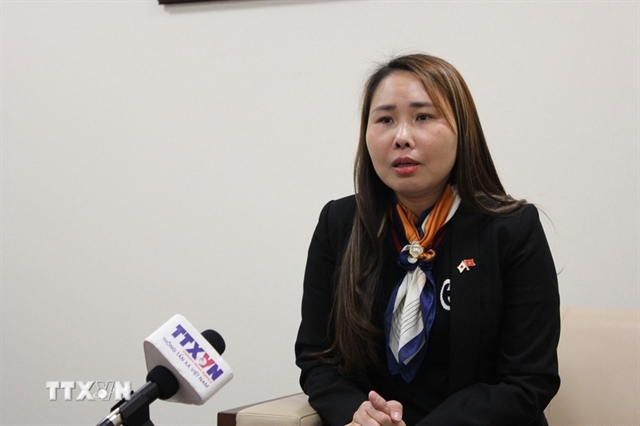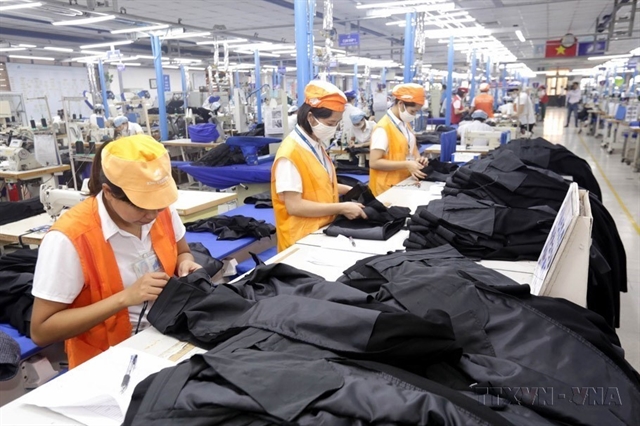 Opinion
Opinion

 |
| Lê Việt Anh, Deputy Head of the Department of Sectoral Finance and Economics. |
In an interview with Việt Nam News reporter Thu Vân ahead of the P4G Summit in Hà Nội, Lê Việt Anh, Deputy Head of the Department of Sectoral Finance and Economics under the Ministry of Finance, member of the P4G Vietnam Summit's Secretariat; and Co-Chair of the P4G National Forum, shares Việt Nam’s expectations as the host country and highlights the pivotal role of international cooperation and experience in supporting the country’s transition towards a low-emission, sustainable economy.
What are Việt Nam’s expectations in hosting the P4G Summit this year? And how do you assess current international cooperation in green finance?
Green finance today is not only a global trend but also an urgent requirement in the journey towards sustainable development. For Việt Nam, green finance is a critical tool to realise the nation’s commitment to achieving net zero emissions by 2050.
Based on models used during the drafting of the National Green Growth Strategy for 2021–2030, with a vision to 2050, and the National Action Plan on Green Growth for 2021–2030, taking into account the net-zero commitment, investment demand for green growth sectors—including clean energy, sustainable agriculture, green transport and low-carbon infrastructure—is estimated at around US$300–350 billion by 2030.
By 2040, total investment demand for green transformation may reach approximately US$368 billion, with energy alone accounting for over 60 per cent. According to the World Bank and the International Energy Agency, under net-zero scenarios, capital needs could rise to US$670–700 billion by 2050. Clearly, public funding alone is insufficient and mobilising green finance from private and international sources will be decisive.
In recent years, Việt Nam has made significant progress in promoting green credit, developing guidelines for green bonds, piloting carbon markets, and actively engaging with international organisations such as the World Bank, ADB, and GCF to implement large-scale projects.
Early-stage models, such as offshore wind energy projects receiving technical support from the World Bank and financial advice from global investment institutions, show the vast potential of green finance.
However, Việt Nam’s green finance framework is still under development and requires technical support, international standards and experience.
The P4G Summit in Hà Nội is particularly meaningful, as Việt Nam is both the host and a country undergoing profound transformation. It offers us the opportunity to showcase a portfolio of strategic green projects—from electrified urban systems and circular agriculture to low-carbon logistics.
We hope P4G will connect financial, technological and policy resources between Việt Nam and development partners, while also fostering initiatives for public–private partnerships and blended finance suited to Việt Nam’s conditions.
More importantly, P4G is expected to serve as a model for Việt Nam’s green finance journey in the coming period.
What is the main message Việt Nam wishes to convey to the international community through the P4G Summit?
As a developing country highly vulnerable to climate change, Việt Nam has identified green transformation as an essential path towards sustainable development and deeper global economic integration.
With our pledge to achieve net zero by 2050, we are working to build a robust green finance framework, promote carbon markets, and mobilise both domestic and international resources to realise this goal.
At the P4G Summit in Hà Nội, Việt Nam wishes to send a strong message of proactivity, cooperation and shared development.
We call upon the international community, financial institutions, investors and businesses to join Việt Nam in creating a green financial ecosystem that is fair, transparent and efficient. This is a crucial moment to harness public–private partnerships, blended finance and green technology transfer to advance key projects such as renewable energy, clean transport, circular agriculture and low-carbon infrastructure.
P4G Hà Nội is not only a platform for stakeholder engagement but also a forum for action—where ideas are translated into reality through practical support mechanisms. With the Summit’s theme 'A Global Partnership for Inclusive, Sustainable, Innovative and People-centred Green Transition', Việt Nam reaffirms its commitment to being a proactive, reliable and creative partner in building a sustainable future for the region and the world.
While Việt Nam has made strong commitments to green growth goals, domestic financial resources remain limited. What is the Ministry of Finance’s strategy to balance internal and international resources in pursuing these ambitious goals?
Việt Nam has demonstrated a strong commitment to climate action and green growth goals. At the same time, we are fully aware that domestic resources—both financial and institutional—remain limited. Public investment allocated to green projects is still modest compared to actual needs, while the private sector remains cautious due to limited information, high risks, and a lack of suitable guarantee mechanisms.
In addition, Việt Nam’s financial market is still in the early stages of developing specialised instruments such as green bonds and sustainable credit.
Given these challenges, the Ministry of Finance has outlined a green finance strategy based on three core pillars: establishing a transparent, stable and investment-friendly regulatory framework for green finance; developing the domestic green finance market; and creating mechanisms to effectively mobilise and coordinate international resources.
 |
| Textile and garment businesses of Việt Nam are working to adopt green practices. VNA/VNS Photo |
On the regulatory front, we have issued guidelines for green bond issuance, are drafting rules for the domestic carbon market, exploring links with international carbon markets, and studying carbon pricing mechanisms suited to Việt Nam’s conditions.
To develop the market, the Ministry of Finance has partnered with international organisations to pilot green bond issuance by enterprises and is preparing for the launch of Government green bonds—a key step in market development.
In terms of international cooperation, Việt Nam is working with the World Bank, the Asian Development Bank, the Green Climate Fund and other climate investment funds to develop blended finance mechanisms. These include using a portion of ODA and concessional loans as a catalyst to unlock private capital for renewable energy and climate-resilient agriculture.
One notable example is the proposal to establish a national green investment fund under a public–private partnership model, with guidance from the Green Climate Fund and international investors. This fund is expected to offer co-financing, guarantees and risk-sharing mechanisms to support carbon-neutral projects in Việt Nam.
We hope the upcoming P4G Summit will help mobilise funding, expertise, and partnerships to accelerate the implementation of these strategies.
One of Việt Nam’s greatest challenges is transitioning to a low-emission economy while maintaining high economic growth. How does the Ministry of Finance view this issue and what are the key financial solutions?
This is a major challenge for Việt Nam and one faced by many developing countries: how to reconcile rapid economic growth with a shift towards a low-emission, sustainable development model.
The foremost challenge is the enormous cost of transition. In the energy sector alone, emission reduction costs run into tens of billions of US dollars annually. Moreover, current institutional capacity, human resources and technological readiness are not yet sufficient to implement green solutions across the economy at scale.
Relying solely on the state budget is clearly unsustainable.
Therefore, the Ministry of Finance has identified the core financial solution as building a dynamic and effective green finance ecosystem that can lead private sector investment. This includes: developing green bonds and green credit as long-term capital mobilisation channels for low-emission projects; establishing risk-sharing mechanisms through credit guarantees, co-financing, and green investment funds to unlock private capital; and using public funds as strategic ‘seed capital’ to invest in key sectors that have ripple effects and attract additional resources.
Việt Nam has already taken concrete steps—such as developing a roadmap for issuing Government green bonds, strengthening cooperation with the ADB and the World Bank on blended finance mechanisms, and exploring the establishment of a national climate investment fund under the PPP model.
The Ministry of Finance is committed to continuing institutional reforms, improving transparency in green financial information and working closely with the private sector to create a finance ecosystem that supports green growth without compromising economic momentum.
As international capital increasingly favours projects with strong environmental and social responsibility, how should Việt Nam reform financial regulations, especially in budget and public investment management, to align with this global trend?
Việt Nam is facing an urgent need to further reform financial regulations—from budgeting and public investment management to capital mobilisation—in response to a global shift towards prioritising projects that meet environmental, social and governance (ESG) criteria. This is not only a financial trend but a new standard for development.
As the central agency for finance and investment, the Ministry of Finance is actively working to integrate green and sustainable criteria into the entire public financial management cycle. This includes developing a green budgeting classification framework and gradually embedding climate and environmental considerations into the planning, allocation and monitoring of State budget expenditure. This will lay the foundation for forming a green budget—an instrument increasingly adopted worldwide to guide public spending towards sustainability.
In terms of public investment, we are reviewing processes for appraisal and capital allocation to incorporate green, low-carbon and climate-resilience criteria from the project planning stage. This approach is being aligned with efforts to prioritise access to public investment capital and international blended finance for projects that meet ESG standards.
Simultaneously, we are finalising the legal framework for issuing green Government bonds to expand long-term capital mobilisation for sustainable infrastructure, clean transport, renewable energy and circular agriculture.
By harmonising both the budgeting and public investment systems with green standards, we aim to build a public finance ecosystem that actively supports the transition to a green, low-emission economy—while also attracting responsible international investment. VNS